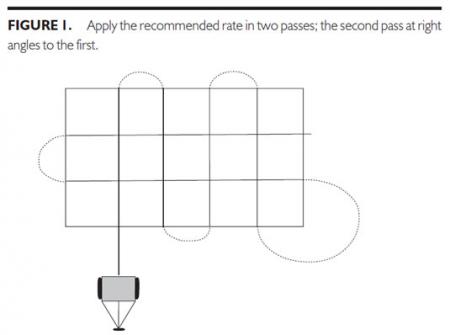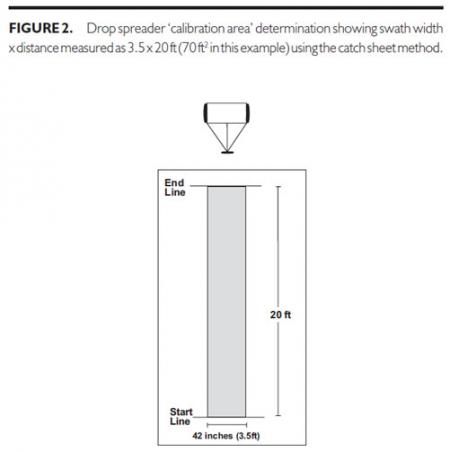Drop Spreader Calibration Procedures
The accurate application of lawn materials requires proper calibration of lawn spreaders of which there are two basic types:
- drop spreaders
- rotary spreaders
Most professional grade fertilizers and pesticides come with directions for calibration and recommended spreader settings. However, these recommended settings are "suggested" spreader settings and are a good starting point but should be validated by calibration
Regardless of the material (fertilizer, seed, pesticides), spreader calibration procedures will be the same for any granular type material providing the material is free flowing.
In the examples given below using different calibration methods a 20-5-10 fertilizer will be calibrated to deliver 1 pound of nitrogen (N) per 1,000 square feet. (1000 square feet is abbreviated as "M").
To achieve this desired N rate, 5.00 pounds of total material (TM) per 1,000 square feet needs to be applied. This is calculated as:
The spreader is properly calibrated when the calibration rate is within ± 5% of the recommended 5.00 lb. (in this example when the calibration rate falls between 4.75 to 5.25 lbs. of fertilizer per 1,000 sq. ft.).
A more uniform application can be obtained if the recommended rate is applied in two applications; one half the rate is applied in one direction and the other half at right angles to the first as shown in Figure 1. If this strategy is used then the calibration rate is cut by half. In our example, the recommended rate in order to apply 20-5-10 at 1.0 lb. N per 1,000 sq. ft. is reduced by half and the calibration rate is 2.5 lb. of 20- 5-10 per 1,000 sq. ft. The procedures outlined below are based on a calibration in which the material is to be applied in a single application. However, the calibration procedures are exactly the same for the single-pass and double-pass application strategy.
Drop Spreader Calibration Procedures
Drop spreaders are uniform in the distribution pattern of granules across the swath width. The swath width of the spreader (the spreader hopper width) will vary with the model and make but may range from 22 to 42 inches or more. Always read manufacturer's directions for proper spreader operation and calibration procedures. Some basic 'rules for the road' are provided here along with calibration procedures for drop type spreaders.
Drop spreader operation:
- Walk at normal speed (5 ft per sec); a faster pace will result in a lighter application rate.
- Avoid skips and excessive overlap; only a slight overlap of the wheels is necessary.
- Avoid non-uniform spreading when turning; always turn off spreader when turning corners.
- Treat the strips at both ends of the area first; this allows you to start in this strip and turn the spreader on/ off in this area.
- Check for clogging; clogging of openings in the bottom of the hopper is common when treating moist turf.
- Monitor application usage and treatment area during spreader operations to check calibration accuracy; if ten 50 lb. bags are required to treat an area and 3 bags have been used when half the area has been treated, something is wrong!
"Catch Sheet Method" Calibration Procedure:
- Select a setting for the spreader; if available, use a manufacturer's recommendation as a starting point.
- Fill the hopper with material, at least half full.
- Operate the spreader over a large enough sheet of plastic, cloth, or paper, such as a painter's drop cloth, to capture all the material.
- Measure the area covered as: distance x swath width.
- Collect and weigh the material on the sheet.
- The application rate based on a standard weight per unit area is pounds per 1,000 square feet and is determined using the following formula:
- Adjust the rate setting and repeat the process until the desired rate is achieved.
- Record the material, rates, and settings in a record book for later reference. In this example:
- The spreader width is: 42 inches
- The linear distance traveled is: 20 ft.
- Therefore, the calibration area is: 3.5 x 200 ft or 70 sq. ft.
- The fertilizer amount collected from the catch sheet weighs: 165 grams
Using Eq. 1 and converting grams to pounds (1 lb. = 454 grams) the
calibration rate in standard units of lb. per 1,000 sq. ft. is calculated as:
Hence, the calibration rate of 5.2 lb. per 1,000 sq. ft. is within ± 5% the recommended rate of 4.75 to 5.25 lb. of 20-5-10 fertilizer per 1,000 sq. ft.
NOTE: A variation of this method called the 'Clean Sweep' method uses clean dry pavement or a shop floor to which the material is applied then collected (swept clean) and weighed.
"Catch Pan Method" Calibration Procedure:
- Professional drop spreaders have catch pan attachments available for calibration purposes. Alternatively, using cardboard, sheet metal, plastic, or PVC pipe a catch pan can be made to cover the entire length of the hopper to collect material during calibration.
- Attach the pan to the bottom of the hopper using hooked elastic cords (bungee cords). Make sure the spreader controls continue to operate properly.
- Operate the spreader over a measured area. Measure the area covered as distance x spreader width.
- Weigh the material collected in the catch pan, and continue at step 6 in 'Catch Sheet Method' Calibration Procedure above.
Adapted from: The Mathematics of Turfgrass Maintenance (2nd Edition, Ann Arbor Press, Inc., Chelsea MI) by N. E. Christians and M. L. Agnew; Lab Manual: Turfgrass Science and Management (2nd Edition, Delmar Publishers, Albany, NY) by R. Emmons and R. Boufford.
--
Revised: 05/2011




